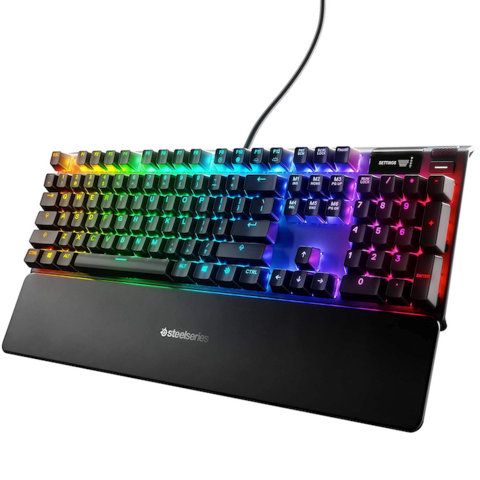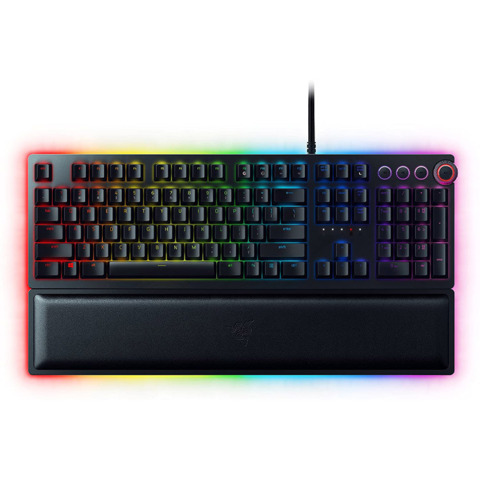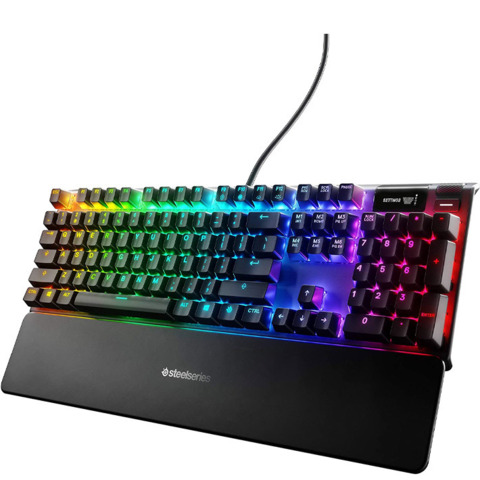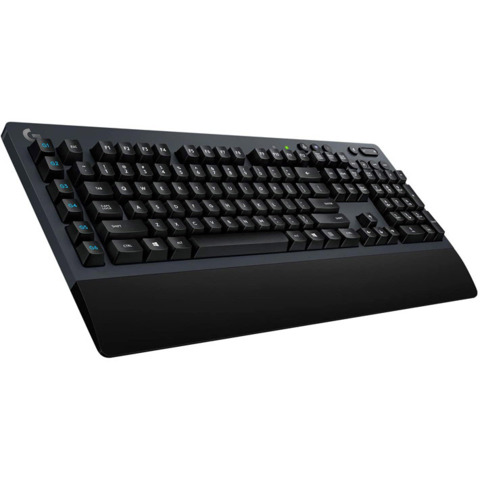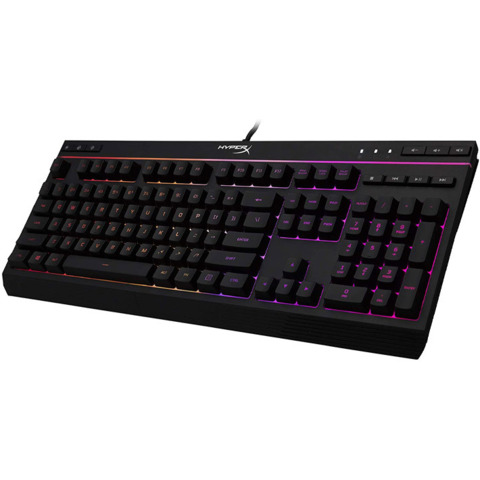Your gaming keyboard choice is one of the most important decisions you can make for your setup. If you thought choosing a mouse or headset was hard, then you’re in for quite the task with gaming keyboards. Between key switches, mechanical vs membrane keyboards, and all the extra features that keyboards tend to come with–such as multimedia keys and RGB lighting–there is a lot to consider. That’s why we’ve tested and narrowed down the field of only the best gaming keyboards you can buy in 2022. For details on the differences between various keyboard switches, scroll down below the list. Our list of the best gaming keyboards includes wireless and wired options as well as keyboards with different form factors and switches.
Looking to complete your gaming keyboard and mouse combo, or just want more gaming peripherals to shop for? Check out our picks for the best gaming headset and best gaming mouse. And if you are trying to find something new to play, we have a roundup of the best PC games to play in 2022. We also have a list of the best Steam Deck games, if you’ve managed to get your hands on Valve’s new handheld.
Editor’s Note: Article updated on July 22, 2022
SteelSeries Apex 7
The Good
- Premium switches
- Excellent build quality
- Magnetic wrist rest promotes comfort
- On-keyboard customization is a breeze
The Bad
The SteelSeries Apex 7 nabs the top spot on our list thanks to a great combination of value and performance. The Apex 7 has a premium build thanks to its “aircraft grade” aluminum alloy materials. Regardless of your preferences for switches, the Apex 7 can accommodate. If you like quiet tactile keys with fast actuation, the brown switches are the ideal choice. For those who want to have tactile switches that provide more audio feedback, opt for the blue. You can also get stealthy linear switches by picking red. The Apex is equipped with anti-ghosting tech and 104 key rollover.
The Apex 7 comes with a magnetic wrist rest for added comfort. It’s one of the best wrist rests we’ve used alongside a gaming keyboard, as it’s ergonomically designed and just the right size to offer enough support while not feeling bulky. Like most keyboards on this list, the Apex 7 has RGB lighting that boasts 16.8 million color options per key.
With five customizable profiles–no additional software required–you can easily cycle through different keyboard input layouts for your favorite games. The Apex 7 has a dedicated media roller, a small OLED display that shows settings, and USB passthrough support.
- Switch Types: Brown, Red, Blue
- Available in Tenkeyless: Yes
Razer Huntsman Elite
The Good
- Razer’s own switches are some of the best out there
- Strong, hefty build quality
- Excellent media buttons
- Comfortable wrist support pad
- Low actuation point means slightly faster input registry…
The Bad
- …but can lead to typos or mistaken inputs
The Razer Huntsman Elite is a fantastic full-sized mechanical keyboard, thanks to Razer’s excellent in-house switches, strong build quality, and comfortable wrist support. The Huntsman Elite pairs its mechanical switches with optical sensors that make for fast inputs, and its keycaps feel great to both type and game on. The optical sensors take your input before you’ve pushed the key down the whole way, which makes the keyboard register keystrokes faster but also more likely to create typos if you’re not used to it. This is particularly true when typing fast, but thankfully, I didn’t notice it much while playing first-person shooters like Rainbow Six Siege and Valorant.
The build quality is also quite impressive. Its heavy and substantial chassis makes it feel like a brick, though the size is quite compact for a fully-featured keyboard. It makes use of the entire surface and features distinct, satisfyingly clicky media buttons for pausing, playing, and skipping. These are extremely easy to navigate to and press thanks to their distinct shape and size, which I found useful for pausing podcasts, YouTube videos, and music while playing games that required more of my attention.
Each Huntsman Elite also comes with a padded wrist support that magnetically attaches to the bottom of the keyboard and syncs with its Chroma lighting patterns. It’s not the best wrist pad out there, but it offers adequate support for your wrists while you type and game for long sessions. The Razer Huntsman Elite is one of the best high-end keyboards out there, and if you’re looking for a tactile-switch gaming keyboard, it’s hard to beat it.
- Switch Types: Razer Linear Optical Switch, Clicky Optical Switch
- Available in Tenkeyless: Yes
SteelSeries Apex Pro
The Good
- Adjustable mechanical switches are impressive
- Switches are smooth and relatively quiet
- Very solid and compact (ignoring the wrist rest) construction
- Lots of meaningful luxuries that make it feel high-end
- Comprehensive customisation software
The Bad
- It’s relatively expensive
The SteelSeries Apex Pro is a high-end keyboard that, on top of looking and feeling the part in basically all respects, sports a pretty innovative feature that currently only exists in maybe one other keyboard: Adjustable mechanical switches. That’s right–you can adjust the trigger point of each individual key on the main key spread to suit your preference, meaning you can program them to only activate on a full, concerted press (about 3.6mm) or the lightest of touches (a shallow 0.4mm).
Is that useful? It can be! A common example would be if you’re a keyboard stickler who spends long stretches of time both typing and playing PC games, like me. You might prefer longer, deeper actuation to help with accuracy and reduce any slips while typing, and a much lighter actuation to increase response times in action games. The SteelSeries Engine software makes it easy to build these profiles (which can be saved onboard the keyboard itself for hardware-side activation), and conveniently allows you to script automatic profile switching for when a particular application becomes active (like Chrome or Apex Legends, for example).
However, it’s worth noting that the linear nature of the switches remains the same regardless, and there are no other options if you prefer a clicky or tactile switch. That said, the way the keys respond can still feel like night and day depending on where you are on the actuation scale.
A host of wholly unnecessary but luxurious features include a tiny OLED display plus a dedicated media playback and volume control wheel, both of which help navigate the onboard UI, which allows you to customise every aspect of the keyboard without having to launch the software, though it’s certainly not as efficient. The display can easily be customised to display 1-bit, 128×40 pixel gifs, and supports integration with a limited selection of programs like Discord, Dota 2, CS:GO, Mortal Kombat 11, and Tidal (if you use Tidal for some reason) to display vital information.
It features USB passthrough, cable routing, macro keys, a magnetic soft rubber wrist rest, and exposed LED lighting for individual keys. The aluminum construction is incredibly durable as you’d expect–it features an exposed keycap design, and it sports a very compact trim, much like the HyperX Alloy Origins (though the lighting isn’t quite as vibrant). Nevertheless, the SteelSeries Apex Pro has everything you’d feasibly want from a premium high-end keyboard, and the adjustable switches are a meaningful customisation feature (even if it seems like a ridiculous flex).
(Note: The more affordable Steelseries Apex 7 sports all the features of the Apex Pro, but comes with more traditional SteelSeries-brand Red, Blue, or Brown switches.)
- Switch Type: OmniPoint Adjustable Mechanical Switches (Apex 7 available in SteelSeries Red, Blue, or Brown)
- Available in Tenkeyless: Yes
Razer Huntsman Tournament Edition
The Good
- Razer’s own switches are among the best
- Strong build quality with aluminum chassis
- Detachable USB-C cable
- Low actuation point means slightly faster input registry…
The Bad
- …but can lead to typos or mistaken inputs
- Keystrokes can be loud, even for linear switches
There’s something novel about a compact tenkeyless keyboard; they’re cute. If you have no use for the number pad and/or want to have a minimalist desk setup, they’re definitely up your alley. If that’s what you’re into there’s a ton of options out there, as tenkeyless is quite popular among the PC gaming crowd, which was born out of the need for small keyboard at cramped LAN competitions. But which one should you get? The Razer Huntsman Tournament Edition is an easy choice.
Razer’s Huntsman keyboards have a sleek aluminum chassis and an overall no-nonsense design. The Tournament Edition specifically is the tenkeyless version, and it features a long detachable braided USB-C cable, which makes it easier to take places if you need to. It also retains the Razer Chroma RGB lighting though the backlighting isn’t as vibrant as other Razer keyboards. What makes these keyboards special are the options you have for mechanical switches. Each of Razer’s own switches (Green, Yellow, and Orange) are tuned for competitive gaming with short actuation points and fine-tuned reset points; they’re also consistently smooth to the keystroke. I’ve mainly used Razer Yellow with the Huntsman TE, and it’s my preferred setup for when things get serious.
The fast response and short actuation point may also lead to more errant inputs, mainly from resting your hand on the keys; it’s something to be mindful of. And the Huntsman isn’t designed for the courtesy of others around you as full keystrokes can be really loud. If neither of those are big concerns, then it’d be hard to overlook the Razer Huntsman.
- Switch Types: Razer Orange, Green, or Yellow
- Available not in Tenkeyless: Yes
SteelSeries Apex 3 TKL
The Good
- Ultra-quiet keys
- Under $50
- Compact design
The Bad
- No profile support
- Not as much RGB customization as others
If you’re for a solid gaming keyboard for under 50 bucks, the SteelSeries Apex 3 is a wonderful option. The Apex 3 features tactile switches that barely make a sound when pressed, so it’s a great option for those who want high-quality switches without the constant clattering while typing.
Even at this price point, the Apex 3 still has some lovely features, including anti-ghosting tech, RGB illumination that’s customizable across eight zones, a water resistant design, media keys, and a volume roller. It also has a cable management system that can help keep your desk looking clean. The Apex 3’s keys are graded for 20 million clicks, so you’re still getting a gaming keyboard that is built to last.
Switch Types: Whisper Quiet (tactile and silent)
Available in Tenkeyless: Yes
Logitech G613
The Good
- Long battery life (AA required)
- Fast input response that matches that of wired keyboards
- Affordable, especially considering how few options are available
- Romer-G tactile switches work well
The Bad
- Plastic wrist rest comes attached, making it a bit bulky overall
- No RGB lighting
Wireless mechanical keyboards are hard to come by, since there are so few options available. That’s not the only reason why we recommend the Logitech G613, though. Input latency is at the top of concerns, but that’s been largely solved as seen with wireless gaming mice, and Logitech adapts its “Lightspeed” tech found in its mice for the G613. It’s also a fantastic budget gaming keyboard.
The G613 is a full-size keyboard in every sense. It features a built-in plastic wrist rest, which is handy, but not detachable. There are six programmable macro keys on the left side of the keyboard and a suite of media controls at the top-right, too. Most importantly, the G613 stands among the great mechanical keyboards out there because of its fast response and accurate mechanical switches. It only comes with Romer-G tactile switches, which isn’t so bad because these provide all the benefits of a mechanical switch like smooth, consistent keystrokes.
While you’ll need to stock up on AA batteries, the G613 is quite efficient, lasting up to 18 months according to Logitech–it’s so efficient, we’re not even talking in hours anymore. It’d be pretty annoying to swap out batteries for a keyboard every few months, so this is key. A reason why battery life last this long is because one common feature has been left behind: backlit keys. Keys are painted in a vibrant white that helps visibility, but of course it’s not the same as proper backlighting.
Considering its feature set and the fact that it’s wireless, the Logitech G913 is a bargain. Plus it’s almost always on sale nowadays. The prospect a wireless gaming keyboard may not be as appealing as a wireless mouse (you’re not constantly moving a keyboard around and dragging a cord after all), but those who want to cut the cord without sacrificing keyboard quality have a great option here.
- Switch types: Romer-G Tactile
- Available in Tenkeyless: No
Corsair K68
The Good
- Solid, sturdy build that’s also water-resistant
- Dedicated media keys are convenient
- Smooth keystrokes with multiple options for Cherry MX switches (for RGB models)
The Bad
The Corsair K68 is an all-around solid keyboard–solid, of course, as in it can take a beating. It’s pitched as the mechanical keyboard that’ll withstand the hazards that might accompany someone’s desk, like spilled liquids. On to of being water-resistant, it’s housed by a thick, sturdy chassis. While Corsair’s product page shows the keyboard being showered on, we tested it ourselves in our K68 review–it turns out it can take showers. There’s a protective membrane beneath the keycaps and shields the mechanical switches from damage, and any liquid it takes on is funneled out of the board.
Those are some of the perks specific to the K68, but it’s an overall top performer. We’ve only used it with Cherry MX Red switches and, as expected, they work like a charm, providing smooth and responsive keystrokes. You have a few options when it comes to K68 models, however. There’s a cheaper version that only comes with red LED backlighting and Red switches, but you’ll have to kick in a few more bucks to get the RGB backlit version which also lets you choose between Cherry MX Red, Blue, or Speed switches. Both models do feature some nice, chunky media control buttons at the top-right, and they come packed with a detachable wrist rest with rubber texture.
There’s nothing bad to say about the K68, really. You can’t go wrong if you’re looking for a great mechanical keyboard, especially if you’re accident-prone or just want to make sure your investment doesn’t get destroyed so easily. It’s also a budget gaming keyboard, especially if you can find it on sale.
- Switch types: Cherry MX Red, Blue, or Speed
- Available in Tenkeyless: No
SteelSeries Apex Pro Mini
The Good
- Adjustable registration depths
- Bluetooth 5.0 connectivity
- 2-in-1 Action Keys
The Bad
The Apex Pro Mini packs a lot of keyboard into not a lot of space. One of its coolest features is the ability to map two actions to a single key–with each action tied to a different actuation depth. This makes it easy to map every function you need to just a handful of keys, something you’ll be thankful for as this 60% keyboard lacks directional keys and a number pad.
Beyond assigning two functions to one key, you can also manipulate the overall registration depth of your keys. Whether you want to activate the key at just 0.2mm or hammer your keyboard to 3.8mm, the Apex Pro Mini lets you modify its actuation depths to your heart’s content. It has the same OmniPoint mechanical switches seen in the standard Apex Pro, so you’re essentially getting the same feel, just in a more compact layout.
This high-end keyboard is completed with the inclusion of RGB lights, a durable aluminum alloy top plate, and PBT keypads that’ll withstand everything you throw at them. You can also connect wirelessly or with USB-C, making it easy to get the board up and running with your setup.
- Switch types: OmniPoint Adjustable Mechanical Switches
- Available not in Tenkeyless: Yes
Razer BlackWidow V3 Mini HyperSpeed
The Good:
Excellent battery life
Durable keycaps
Multiple connectivity modes
The Bad:
N/A
For the gamer on the go, the Razer Blackwidow V3 is a terrific combination of portability, rugged durability, and satisfying tactile feedback. This keyboard can be connected via Bluetooth, Hyperspeed Wireless, or through a traditional USB-C cable, has up to 200 hours of battery life, and can be topped up with a fresh supply of electricity in a handful of hours.
As for the keys, Razer’s Yellow mechanical switches mean that you can hammer away at the opposition while enjoying its low sound profile, and the doubleshot ABS keycaps will ensure that the labeling never wears off with repeated use.
Switch Types: Razer Yellow and Green
Available not in Tenkeyless: Yes
HyperX Alloy Core RGB
The Good:
Budget-friendly price
RGB-lighting for days
Membrane keys for silent typing
The Bad:
N/A
Mechanical keyboards may have their fans, but the input devices which use a softer membrane construction are still worth looking at in today’s gaming scene. HyperX’s Alloy Core features just such a design, as its construction allows for quiet and responsive keys, spill resistant in case of potential Pepsi peril, and an attractive price.
It’s also a bright keyboard thanks to the dynamic RGB lighting effects spread throughout it, and if you’re looking to sit back with music and moves, the dedicated media controls will come in handy.
Switch Types: Membrane keys
Available in Tenkeyless: Yes
Keyboard switches, explained
Different types of switches will appeal to different and whether you’re going with a Cherry MX switch like Cherry MX Red or Cherry MX Blue, there are plenty of keyboards worth your time. It can get confusing quickly, especially if you can’t test these keyboards yourself and truly tell the difference with your own fingers. Thankfully, it’s easy to understand exactly what you’ll be getting if you understand the terminology.
First off, linear versus tactile switches keys. Linear means there is no physical feedback mechanism to indicate when a keystroke is registered. It’s smooth, relatively quiet, and preferred for rapidly tapping on keys. Tactile means there is a bump or click to indicate you’ve hit the actuation point; it’s louder, but some prefer having physical feedback for keystrokes. It really comes down to preference. Actuation point is the distance at which a keystroke is registered; a shorter distance means you don’t have to press the key down as far, but can lead to errant inputs. Actuation force is, well, the force needed to press the key down. Of course, there are all the quality-of-life considerations to think about, too, like multimedia keys, whether you want a programmable key row and such.
While Cherry has been the long-time dominant manufacturer of mechanical switches, some gaming peripheral brands have started making their own proprietary mechanical switches for their keyboards, namely Razer and Logitech. For a brief overview of the most common mx switches, see below:
- Cherry MX Red Switches: Linear
- Cherry MX Blue Switches: Tactile and Clicky
- Cherry MX Brown Switches: Tactile with a Bump
- Cherry MX Speed Switches: Linear with a very short actuation point
- Romer-G Linear Switches: Linear
- Romer-G Tactile Switches: Tactile with a Bump
- Razer Yellow Switches: Linear
- Razer Orange Switches: Tactile with a Bump
- Razer Green Switches: Tactile and Clicky
- Steelseries OmniPoint Adjustable Switches: Linear with adjustable actuation point
The products discussed here were independently chosen by our editors.
GameSpot may get a share of the revenue if you buy anything featured on our site.
Stay connected with us on social media platform for instant update click here to join our Twitter, & Facebook
We are now on Telegram. Click here to join our channel (@TechiUpdate) and stay updated with the latest Technology headlines.
For all the latest Gaming News Click Here

